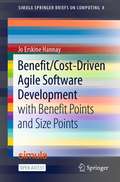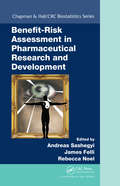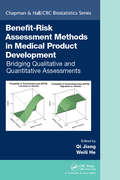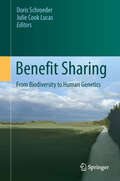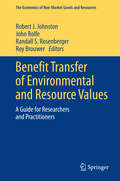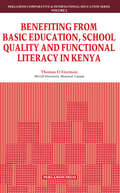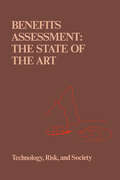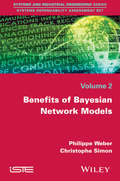- Table View
- List View
Benefit/Cost-Driven Software Development: With Benefit Points and Size Points (Simula SpringerBriefs on Computing #8)
by Jo Erskine HannayThis open access book presents a set of basic techniques for estimating the benefit of IT development projects and portfolios. It also offers methods for monitoring how much of that estimated benefit is being achieved during projects. Readers can then use these benefit estimates together with cost estimates to create a benefit/cost index to help them decide which functionalities to send into construction and in what order. This allows them to focus on constructing the functionality that offers the best value for money at an early stage. Although benefits management involves a wide range of activities in addition to estimation and monitoring, the techniques in this book provides a clear guide to achieving what has always been the goal of project and portfolio stakeholders: developing systems that produce as much usefulness and value as possible for the money invested. The techniques can also help deal with vicarious motives and obstacles that prevent this happening. The book equips readers to recognize when a project budget should not be spent in full and resources be allocated elsewhere in a portfolio instead. It also provides development managers and upper management with common ground as a basis for making informed decisions.
The Benefit of Hindsight: Discover book 10 in the bestselling Simon Serrailler series (Simon Serrailler #10)
by Susan Hill'Serrailler, Hill's brilliant detective, is the central character in the great writer's crime fiction novels' CAMILLA, DUCHESS OF CORNWALL'Beautifully told, Hill's gimlet eye and steely prose remind you how fierce she can be' Daily Mail One rainy night, a couple welcomes two strangers needing help into their home. It's an act they will regret for the rest of their lives. On the other side of town a woman is brutally murdered and her husband is left unconscious. Are the two crimes connected? Detective Simon Serrailler sets out to investigate but will his own demons get in the way?'Keepers the reader gripped until the last page' Sunday ExpressDiscover the bestselling Simon Serrailler series that over ONE MILLION readers have devoured.
The Benefit of the Gift: Social Organization and Expanding Networks of Interaction in the Western Great Lakes Archaic (International Monographs in Prehistory: Archaeological Series #18)
by Mark Andrew HillArchaeological data from the Late Archaic (4000-2000 years ago) in the Western Great Lakes are analyzed to understand the production and movement of copper and lithic exchange materials. Also considered in this volume are access to and benefits from exchange networks, as well as social changes accompanying the development of extensive, continental scale, exchange systems of interaction in this period.
Benefit Realisation Management: A Practical Guide to Achieving Benefits Through Change
by Gerald BradleyThe first edition of Gerald Bradley's Benefit Realisation Management quickly established itself as the definitive, practical guide to using measures to track performance throughout the life of a project or programme; enabling organisations to eliminate wasted investment, realise more benefits and realise them earlier. The second edition takes you step-by-step through the benefits realisation process, explaining along the way, how to: * define your projects and programmes by mapping the benefits * produce a convincing and accurate business case * communicate the benefits and get all your stakeholders on board * agree the measures you will use to encourage the desired behaviours, to monitor progress and to assess the ultimate success of the project or programme * use the benefits realisation approach to understand and address the human aspects of the project, including resistance to change, training needs and new ways of working * integrate this approach into your organisation's culture and systems The second edition includes expanded guidance on benefits realisation for portfolio management and includes revisions to the original text along with additional case study examples. The text of the latest edition is now printed in four-colour which make the detailed and varied benefit maps throughout the text immediately more striking and comprehensible. The benefits realisation management methodology fits closely with existing programme and project management approaches such as MSP and Prince 2, making it appropriate for both public and private sector environments. If you are investing heavily in change management, IT infrastructure or project working, then this book is a must-read that will justify its price many times over.
Benefit Realisation Management: A Practical Guide to Achieving Benefits Through Change
by Gerald BradleyThe first edition of Gerald Bradley's Benefit Realisation Management quickly established itself as the definitive, practical guide to using measures to track performance throughout the life of a project or programme; enabling organisations to eliminate wasted investment, realise more benefits and realise them earlier. The second edition takes you step-by-step through the benefits realisation process, explaining along the way, how to: * define your projects and programmes by mapping the benefits * produce a convincing and accurate business case * communicate the benefits and get all your stakeholders on board * agree the measures you will use to encourage the desired behaviours, to monitor progress and to assess the ultimate success of the project or programme * use the benefits realisation approach to understand and address the human aspects of the project, including resistance to change, training needs and new ways of working * integrate this approach into your organisation's culture and systems The second edition includes expanded guidance on benefits realisation for portfolio management and includes revisions to the original text along with additional case study examples. The text of the latest edition is now printed in four-colour which make the detailed and varied benefit maps throughout the text immediately more striking and comprehensible. The benefits realisation management methodology fits closely with existing programme and project management approaches such as MSP and Prince 2, making it appropriate for both public and private sector environments. If you are investing heavily in change management, IT infrastructure or project working, then this book is a must-read that will justify its price many times over.
Benefit-Risk Appraisal of Medicines: A Systematic Approach to Decision-making
by Filip Mussen Sam Salek Stuart WalkerBenefit-risk assessment is at the centre of the approval process for every new medicine. The ability to assess the risks of a new medicine accurately and to balance these against the benefits the medicine could bring is critical for every regulatory authority and pharmaceutical company. Despite this there are very few tried and tested evaluative models currently available. The authors of this book have developed a new, pioneering tool for the assessment of benefits and risks for new medicines in development. This model utilises a multi-criteria decision analysis which involves selecting, scoring and weighting key benefit and risk attributes and leads to an overall appraisal of benefits and risks of medicines. Benefit-Risk Appraisal of Medicines establishes the background and criteria required to assess benefit and risk in general and reviews the current practices by regulatory authorities and the pharmaceutical industry, including those models currently available. It outlines the development and evaluation of the authors’ new model and analyses the implications of its implementation. Describes an innovative, systematic model which leads to transparent and responsible benefit-risk decision making Contributes important ideas to the debate on benefit-risk appraisal Provides a future framework for benefit-risk appraisal of medicines Benefit-Risk Appraisal of Medicines covers the entire process from the discovery of new medicines to their marketing and is ideal for all those who work in the pharmaceutical industry and regulatory authorities,, as well as post-graduate students of pharmaceutical medicine and clinical pharmacology.
Benefit-Risk Assessment in Pharmaceutical Research and Development
by Andreas Sashegyi James Felli Rebecca NoelMany practitioners in the pharmaceutical industry are still largely unfamiliar with benefit-risk assessment, despite its growing prominence in drug development and commercialization. Helping to alleviate this knowledge gap, Benefit-Risk Assessment in Pharmaceutical Research and Development provides a succinct overview of the key considerations rele
Benefit-Risk Assessment Methods in Medical Product Development: Bridging Qualitative and Quantitative Assessments (Chapman & Hall/CRC Biostatistics Series)
by Qi Jiang Weili HeGuides You on the Development and Implementation of B–R Evaluations Benefit–Risk Assessment Methods in Medical Product Development: Bridging Qualitative and Quantitative Assessments provides general guidance and case studies to aid practitioners in selecting specific benefit–risk (B–R) frameworks and quantitative methods. Leading experts from industry, regulatory agencies, and academia present practical examples, lessons learned, and best practices that illustrate how to conduct structured B–R assessment in clinical development and regulatory submission. The first section of the book discusses the role of B–R assessments in medicine development and regulation, the need for both a common B–R framework and patient input into B–R decisions, and future directions. The second section focuses on legislative and regulatory policy initiatives as well as decisions made at the U.S. FDA’s Center for Devices and Radiological Health. The third section examines key elements of B–R evaluations in a product’s life cycle, such as uncertainty evaluation and quantification, quantifying patient B–R trade-off preferences, ways to identify subgroups with the best B–R profiles, and data sources used to assist B–R assessment. The fourth section equips practitioners with tools to conduct B–R evaluations, including assessment methodologies, a quantitative joint modeling and joint evaluation framework, and several visualization tools. The final section presents a rich collection of case studies. With top specialists sharing their in-depth knowledge, thought-provoking considerations, and practical advice, this book offers comprehensive coverage of B–R evaluation methods, tools, and case studies. It gives practitioners a much-needed toolkit to develop and conduct their own B–R evaluations.
Benefit-Risk Assessment Methods in Medical Product Development: Bridging Qualitative and Quantitative Assessments (Chapman & Hall/CRC Biostatistics Series)
by Qi Jiang and Weili HeGuides You on the Development and Implementation of B–R Evaluations Benefit–Risk Assessment Methods in Medical Product Development: Bridging Qualitative and Quantitative Assessments provides general guidance and case studies to aid practitioners in selecting specific benefit–risk (B–R) frameworks and quantitative methods. Leading experts from industry, regulatory agencies, and academia present practical examples, lessons learned, and best practices that illustrate how to conduct structured B–R assessment in clinical development and regulatory submission. The first section of the book discusses the role of B–R assessments in medicine development and regulation, the need for both a common B–R framework and patient input into B–R decisions, and future directions. The second section focuses on legislative and regulatory policy initiatives as well as decisions made at the U.S. FDA’s Center for Devices and Radiological Health. The third section examines key elements of B–R evaluations in a product’s life cycle, such as uncertainty evaluation and quantification, quantifying patient B–R trade-off preferences, ways to identify subgroups with the best B–R profiles, and data sources used to assist B–R assessment. The fourth section equips practitioners with tools to conduct B–R evaluations, including assessment methodologies, a quantitative joint modeling and joint evaluation framework, and several visualization tools. The final section presents a rich collection of case studies. With top specialists sharing their in-depth knowledge, thought-provoking considerations, and practical advice, this book offers comprehensive coverage of B–R evaluation methods, tools, and case studies. It gives practitioners a much-needed toolkit to develop and conduct their own B–R evaluations.
Benefit-Risk Assessment of Medicines: The Development and Application of a Universal Framework for Decision-Making and Effective Communication
by James Leong Sam Salek Stuart WalkerThis book proposes and investigates a universal framework, and accompanying documentation system, to facilitate and catalogue benefit-risk decisions; a valuable addition to the benefit-risk toolbox.Over the past decade, pharmaceutical companies and regulatory agencies have been reviewing the benefit-risk assessment of medicines with a view to developing a structured, systematic, standardized approach. Examining the evaluation of such an approach by several mature regulatory authorities ensures that the reader gains a unique insight into the ongoing debate in this area.The field of benefit-risk assessment continues to evolve at a rapid pace due to political and societal pressure, as is reflected in the recent FDA PUDFA agreement as well as in the EMA 2015 Roadmap. Rather than provide a comprehensive snap-shot of this constantly changing environment, this book evaluates selected current approaches to benefit-risk assessment. The strengths and weaknesses of publicly available documents in communicating benefit-risk decisions to stakeholders are reviewed and these evaluations are used to inform development of a prospective framework that could be used to harmonise procedures globally.
Benefit Sharing: From Biodiversity to Human Genetics
by Doris Schroeder and Julie Cook LucasBiomedical research is increasingly carried out in low- and middle-income countries. International consensus has largely been achieved around the importance of valid consent and protecting research participants from harm. But what are the responsibilities of researchers and funders to share the benefits of their research with research participants and their communities? After setting out the legal, ethical and conceptual frameworks for benefit sharing, this collection analyses seven historical cases to identify the ethical and policy challenges that arise in relation to benefit sharing. A series of recommendations address possible ways forward to achieve justice for research participants in low- and middle-income countries.
Benefit-sharing in Environmental Governance: Local Experiences of a Global Concept (Earthscan Studies in Natural Resource Management)
by Louisa ParksTaking a bottom-up perspective, this book explores local framings of a wide range of issues related to benefit-sharing, a growing concept in global environmental governance. Benefit-sharing in Environmental Governance draws on original case studies from South Africa, Namibia, Greece, Argentina, and Malaysia to shed light on what benefit-sharing looks like from the local viewpoint. These local-level case studies move away from the idea of benefit-sharing as defined by a single international organization or treaty. Rather, they reflect different situations where benefit-sharing has been considered, including agriculture, access to land and plants, wildlife management, and extractives industries. Common themes in the experiences of local communities form the basis for an exploration of spaces for local voices at the international level in the Convention on Biological Diversity (CBD), often argued to be the most open arena to non-state actors, and therefore vital to how local voices may be included at the global level. The book analyzes the decisions of the CBD parties to produce an in-depth reflection on how this arena builds and delimits spaces for the expression of local community themes, and paths for local community participation including community protocols. The book then situates the bottom-up findings in the wider debate about global civil society and deliberative democracy in environmental governance. This interdisciplinary book will be of great interest to students and scholars of environmental politics, environmental law, political ecology and global governance, as well as practitioners and policymakers involved in multilateral environmental agreements.
Benefit-sharing in Environmental Governance: Local Experiences of a Global Concept (Earthscan Studies in Natural Resource Management)
by Louisa ParksTaking a bottom-up perspective, this book explores local framings of a wide range of issues related to benefit-sharing, a growing concept in global environmental governance. Benefit-sharing in Environmental Governance draws on original case studies from South Africa, Namibia, Greece, Argentina, and Malaysia to shed light on what benefit-sharing looks like from the local viewpoint. These local-level case studies move away from the idea of benefit-sharing as defined by a single international organization or treaty. Rather, they reflect different situations where benefit-sharing has been considered, including agriculture, access to land and plants, wildlife management, and extractives industries. Common themes in the experiences of local communities form the basis for an exploration of spaces for local voices at the international level in the Convention on Biological Diversity (CBD), often argued to be the most open arena to non-state actors, and therefore vital to how local voices may be included at the global level. The book analyzes the decisions of the CBD parties to produce an in-depth reflection on how this arena builds and delimits spaces for the expression of local community themes, and paths for local community participation including community protocols. The book then situates the bottom-up findings in the wider debate about global civil society and deliberative democracy in environmental governance. This interdisciplinary book will be of great interest to students and scholars of environmental politics, environmental law, political ecology and global governance, as well as practitioners and policymakers involved in multilateral environmental agreements.
Benefit Transfer of Environmental and Resource Values: A Guide for Researchers and Practitioners (The Economics of Non-Market Goods and Resources #14)
by Robert J. Johnston John Rolfe Randall S. Rosenberger Roy BrouwerThis book provides a comprehensive review of environmental benefit transfer methods, issues and challenges, covering topics relevant to researchers and practitioners. Early chapters provide accessible introductory materials suitable for non-economists. These chapters also detail how benefit transfer is used within the policy process. Later chapters cover more advanced topics suited to valuation researchers, graduate students and those with similar knowledge of economic and statistical theory and methods. This book provides the most complete coverage of environmental benefit transfer methods available in a single location.The book targets a wide audience, including undergraduate and graduate students, practitioners in economics and other disciplines looking for a one-stop handbook covering benefit transfer topics and those who wish to apply or evaluate benefit transfer methods. It is designed for those both with and without training in economics
Benefiting from Basic Education, School Quality and Functional Literacy in Kenya (Comparative and International Education Series #Volume 2)
by T. O. EisemonStudies of the retention of literacy and numeracy by adults who have only obtained primary schooling have given little encouragement to the belief that the cognitive effects of schooling are enduring for many school leavers. How these findings can be reconciled with the claims made for the importance of schooling as an instrument of social and economic change is the subject ofinvestigation in this volume. The cognitive outcomes of literacy acqusition and secular schools in coastal Kenya are the focus of this ethnographic study, which stresses the relevance of an international understanding of the particular problems and dilemmas that face the educational systems of individual countries.
Benefiting from Thermal and Mechanical Simulation in Micro-Electronics
by G. Q. Zhang L. J. Ernst O. De Saint LegerBenefiting from Thermal and Mechanical Simulation in Micro-Electronics presents papers from the first international conference on this topic, EuroSimE2000. For the first time, people from the electronics industry, research institutes, software companies and universities joined together to discuss present and possible future thermal and mechanical related problems and challenges in micro-electronics; the state-of-the-art methodologies for thermal & mechanical simulation and optimization of micro-electronics; and the perspectives of future simulation and optimization methodology development. Main areas covered are:- The impact of simulation on industry profitability Approaches to simulation The state-of-the-art methodologies of simulation Design optimization by simulation £/LIST£ Benefiting from Thermal and Mechanical Simulation in Micro-Electronics is suitable for students at graduate level and beyond, and for researchers, designers and specialists in the fields of microelectronics and mechanics.
Benefits and Risks of Hormonal Contraception: Has the Attitude Changed?
by A. A. Haspels R. RollandA. A. Haspe/s It is with pleasure that I welcome you, on behalf of Professor Rolland and myself, to Amsterdam for this International Symposium on 'Benefits and Risks of Hormonal Contraception'. As a means offamily planning the pill is about 25 years old - a timespan which has been characterized by an enormous increase in public interest and concern with family health and family-planning. Undoubtedly we have learned a lot over the last 25 years. As you see in Figure 1, in the seventies in Holland relatively more fertile women used the pill than in any other country in the world. In 1974 new combination pills were introduced containing less than 50 JAg of ethinyl estradiol. In 1981 50 % of Dutch pill users took a sub-50 (Figure 2). The same is true for the Scandi navian countries. In our own University Clinic 95 % of pill-users take a sub-50 pill; only 5 % use a 50 JAg pill on medical indication. This decrease in estrogen dosage, which is usually accompanied by a decrease of progestational component as well, has resulted in a decrease of thromboembolic disease. Factors that are still important to consider are diabetes mellitus, hypertension, adipositas and smoking. Good selection of patients together with the prescribing where possible of sub-50 pills may result in the numbers of compli cations and side-effects being close to those encountered in the control group.
Benefits Assessment: The State of the Art (Risk, Governance and Society #1)
by JerylMumpower Vincent T. Covello Judith D. BentkoverIn recent years there has been substantial interest in benefits assessment methods, especially as these methods are used to assess health, safety, and environmental issues. At least part of this interest can be traced to Executive Order 12291, issued by President Ronald Reagan in 1981. This Executive Order requires Federal agencies to perform benefits assessments of pro posed major regulations and prohibits them from taking regulatory action unless potential benefits exceed potential costs to society. Heightened interest in benefits assessment methods has in tum given rise to greater recognition of the inherent difficulties in performing such assess ments. For example, many benefits that are intuitively felt to be most important are also among the most difficult to measure. It can be difficult to identify the full range of both benefits and costs. The choice of an appro priate discount rate for comparing benefits and costs over time is proble matic. Even when benefits are quantifiable in principle and agreement can be reached on their valuation, required d,ata may not be available. Thus considerable uncertainty is built into most benefit estimates, even when they are based on the best available data. In light of the complexities and difficulties associated with the perform ance of a benefits assessment, this book reviews the current state of theoretical and methodological knowledge in the field. The review is extensive in that it covers over fifty years of research, theoretical develop ment, and practice.
Benefits, Costs, and Cycles in Workers’ Compensation (Huebner International Series on Risk, Insurance and Economic Security #9)
by Philip S. Borba David AppelWorkers' compensation insurance presents a set of institutional charac teristics that are unique. For every other form of insurance, both the insurer and the coverage provided under the policy are completely controlled either by the federal or a state government, or by an arrangement between the insured and a property-casualty insurer. Unemployment insurance, Social Security, and bank-deposit insurance are examples for which a legis lative body sets the benefits. and a government agency prescribes the in surance premium. By contrast, the coverage and premiums for automobile, homeowners, and fire insurance are individual contractual arrangements between a policyholder and one of the more than 1800 U. S. property casualty insurance companies. Workers' compensation insurance, however, is a hybrid in which state legislatures stipulate the terms of coverage, while regulated competition is the major determinant of prices. State legislatures enact statutes that prescribe the replacement rate and duration of indemnity benefits, as well as full reimbursement of medical expenses. And although the manual rates for workers' compensation insurance continue to be administered by a prior approval process in most states, the competitive-market price for coverage is achieved through a variety of price-modification plans (Appel and Borba, 1988).
Benefits Management: How to Increase the Business Value of Your IT Projects (Wiley Series In Information Systems Ser.)
by John Ward Elizabeth DanielThe second edition of Benefits Management has been updated with current examples, further insights from experience and recent research. It shows how the enduring challenges achieving business value from information systems and technology projects can be addressed successfully. The approach, which is synthesized from best practices, sound theories and proven techniques from a range of management disciplines, is exemplified from the authors' extensive experience of working with a wide range of organizations. The book includes examples from a wide variety of projects including non-IT projects. The book is written in an accessible style, ideal for practicing managers, and includes check lists and templates for using the processes, tools and techniques and real-life case studies of their application and impacts. The book now also includes: International survey results that reinforce the importance of the topic, the key management issues and evidence of how the more successful organizations' practices are closely aligned with those described in the book. A Benefits Management Maturity diagnostic which enables organizations to understand the reasons for their current investment success levels and then how to increase them. Discussion of the role and contribution Project Management Offices (PMOs): how they can improve the delivery of value IT projects. Further practical advice and guidance on Program and Portfolio Management, including findings from the authors’ recent research in several large organizations.
Benefits Management: How to Increase the Business Value of Your IT Projects
by John Ward Elizabeth DanielThe second edition of Benefits Management has been updated with current examples, further insights from experience and recent research. It shows how the enduring challenges achieving business value from information systems and technology projects can be addressed successfully. The approach, which is synthesized from best practices, sound theories and proven techniques from a range of management disciplines, is exemplified from the authors' extensive experience of working with a wide range of organizations. The book includes examples from a wide variety of projects including non-IT projects. The book is written in an accessible style, ideal for practicing managers, and includes check lists and templates for using the processes, tools and techniques and real-life case studies of their application and impacts. The book now also includes: International survey results that reinforce the importance of the topic, the key management issues and evidence of how the more successful organizations' practices are closely aligned with those described in the book. A Benefits Management Maturity diagnostic which enables organizations to understand the reasons for their current investment success levels and then how to increase them. Discussion of the role and contribution Project Management Offices (PMOs): how they can improve the delivery of value IT projects. Further practical advice and guidance on Program and Portfolio Management, including findings from the authors’ recent research in several large organizations.
Benefits of Bayesian Network Models
by Philippe Weber Christophe SimonThe application of Bayesian Networks (BN) or Dynamic Bayesian Networks (DBN) in dependability and risk analysis is a recent development. A large number of scientific publications show the interest in the applications of BN in this field. Unfortunately, this modeling formalism is not fully accepted in the industry. The questions facing today's engineers are focused on the validity of BN models and the resulting estimates. Indeed, a BN model is not based on a specific semantic in dependability but offers a general formalism for modeling problems under uncertainty. This book explains the principles of knowledge structuration to ensure a valid BN and DBN model and illustrate the flexibility and efficiency of these representations in dependability, risk analysis and control of multi-state systems and dynamic systems. Across five chapters, the authors present several modeling methods and industrial applications are referenced for illustration in real industrial contexts.
Benefits of Bayesian Network Models
by Philippe Weber Christophe SimonThe application of Bayesian Networks (BN) or Dynamic Bayesian Networks (DBN) in dependability and risk analysis is a recent development. A large number of scientific publications show the interest in the applications of BN in this field. Unfortunately, this modeling formalism is not fully accepted in the industry. The questions facing today's engineers are focused on the validity of BN models and the resulting estimates. Indeed, a BN model is not based on a specific semantic in dependability but offers a general formalism for modeling problems under uncertainty. This book explains the principles of knowledge structuration to ensure a valid BN and DBN model and illustrate the flexibility and efficiency of these representations in dependability, risk analysis and control of multi-state systems and dynamic systems. Across five chapters, the authors present several modeling methods and industrial applications are referenced for illustration in real industrial contexts.
The Benefits of Imperfection: Biology, Society, and Beyond
by Olivier HamantThe cult of performance leads our society to emphasise the values of success and continuous optimisation in all areas. Slowness, redundancy and randomness are therefore negatively perceived. Olivier Hamant, in his book, reclaims them by his knowledge of biological processes.What can we learn from life sciences? While some biological mechanisms certainly boast formidable efficiency, recent advances instead highlight the fundamental role of errors, incoherence or slowness in the robustness of living organisms. Should life be considered suboptimal? To what extent could suboptimality become a counter-model to the credo of performance and control in the Anthropocene?In the face of pessimistic observations and environmental alerts, the author outlines solutions for a future that is viable and reconciled with nature.Key Features: Solidly documents with a grounding in scientific facts focusing on solutions Explores a pragmatic way towards robustness, moving the debate beyond performance, technolatry or degrowth Responds to eco-anxiety by providing an engaging and viable way forward
The Benefits of Imperfection: Biology, Society, and Beyond
by Olivier HamantThe cult of performance leads our society to emphasise the values of success and continuous optimisation in all areas. Slowness, redundancy and randomness are therefore negatively perceived. Olivier Hamant, in his book, reclaims them by his knowledge of biological processes.What can we learn from life sciences? While some biological mechanisms certainly boast formidable efficiency, recent advances instead highlight the fundamental role of errors, incoherence or slowness in the robustness of living organisms. Should life be considered suboptimal? To what extent could suboptimality become a counter-model to the credo of performance and control in the Anthropocene?In the face of pessimistic observations and environmental alerts, the author outlines solutions for a future that is viable and reconciled with nature.Key Features: Solidly documents with a grounding in scientific facts focusing on solutions Explores a pragmatic way towards robustness, moving the debate beyond performance, technolatry or degrowth Responds to eco-anxiety by providing an engaging and viable way forward
